100s of Information Collections Influenced by Presidential Actions in the First 6 Months of the Trump Administration
by Melanie Klein
Highlights: Six Months of Submissions to Reginfo.gov
422 information collection requests (ICRs), representing 400 unique information collections, were identified as having been influenced by Presidential Actions.
36% (422 out of 1,182) of ICRs for new collections or changes to approved collections were impacted.
A total of 21 Presidential Actions were identified as influencing ICRs, including 17 Executive Orders and 4 Proclamations.
The three most influential Presidential Actions were EO 14168 Defending Women (369 ICRs), EO 14151 Ending DEI Programs (61 ICRs), and EO 14148 Rescissions of Harmful EOs (39 ICRs).
The three agencies that submitted the most ICRs influenced by Presidential Actions were HHS (177 ICRs), DOL (30 ICRs), and DOC (26 ICRs).
86% (362 out of 422) of impacted ICRs requested a nonsubstantive change which means that neither a Federal Register Notice nor a public comment period was required.
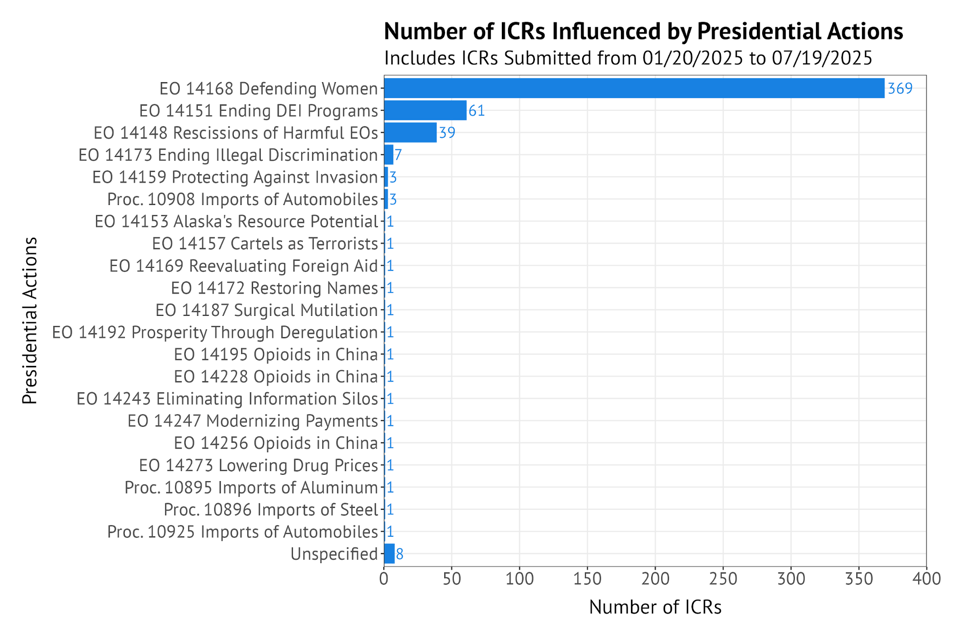
To explore all 422 ICRs influenced by Presidential Actions, visit our Presidential Action ICR tracker.
Tracking ICR Activity
Since January 20, 2025, new Presidential Actions, such as Executive Orders and Proclamations, have required federal agencies to subtly adjust what information they gather and how they ask for it. This is especially true when it comes to language about gender and diversity, equity, and inclusion (DEI). Federal data collections leave a digital trail on Reginfo.gov as they evolve, but some footprints are easier to spot than others.
By conducting a comprehensive review of information collection requests (ICRs) submitted in the first six months of the Trump Administration, 422 ICRs were identified as having been influenced by Presidential Actions. However, this is likely a conservative value: although many ICRs clearly document the Presidential Actions they respond to, some changes can be hidden in new versions of forms or occur without a proper ICR request.
Keep reading for insights into how this review process works and which data collections are being quietly rewritten to align with new policy priorities.
RegInfo and ICRs 101
Thanks to the Paperwork Reduction Act, federal agencies can’t just ask the public for whatever information they want. First, they have to get approval from the Office of Management and Budget (OMB) by submitting an ICR.
OMB is the holder of government forms, surveys, data tools, methodology statements, and more. Agencies must submit an ICR with these documents every time they create a new information collection or revise an existing one, including the required renewal that comes every three years. These requests are publicly documented on Reginfo.gov, which serves as a centralized source of transparency and accountability for federal data collections.
While the primary purpose of ICRs is to ensure that federal collections align with statutory missions, avoid unnecessary or duplicative requests, and minimize burden on the American public, they also offer a valuable lens for spotting changes driven by Presidential Actions. By sifting through supporting statements, change request memos, redlined surveys, and the amended forms themselves, you can uncover the story of the data collection, right down to the revision of a single word. However, some changes may slip through unnoticed if the ICR’s technical documentation is not explicit or if an agency does not report them.
Presidential Actions Behind These Changes
From January 20 to July 19, 2025, 2,357 ICRs were submitted. For this analysis, the 1,182 ICRs that were a new collection or made changes to an approved collection were reviewed. That includes ICRs with a request type of “new collection (request for an OMB Control Number),” “revision of a currently approved collection,” “reinstatement with change of a previously approved collection,” and “no material or nonsubstantive change to a currently approved collection.” That excludes ICRs with a request type of “extension without change or a currently approved collection,” “reinstatement without change of a previously approved collection,” “existing collection in use without OMB control number,” or those involving an RCF.
Among the 422 impacted ICRs, there are 400 unique OMB control numbers, each representing an information collection. For the 15 collections with multiple ICRs attributed to them, they ranged from two to five requests.
A total of 21 Presidential Actions were identified as influencing ICRs, including 17 Executive Orders and 4 Proclamations. Because ICRs can be impacted by more than one Presidential Action, the totals below add up to more than 422:
ICR Insights
Now that we’ve identified how many ICRs were influenced by each Presidential Action, let’s dig into other key features, including how they vary by request type, across agencies, and over time.
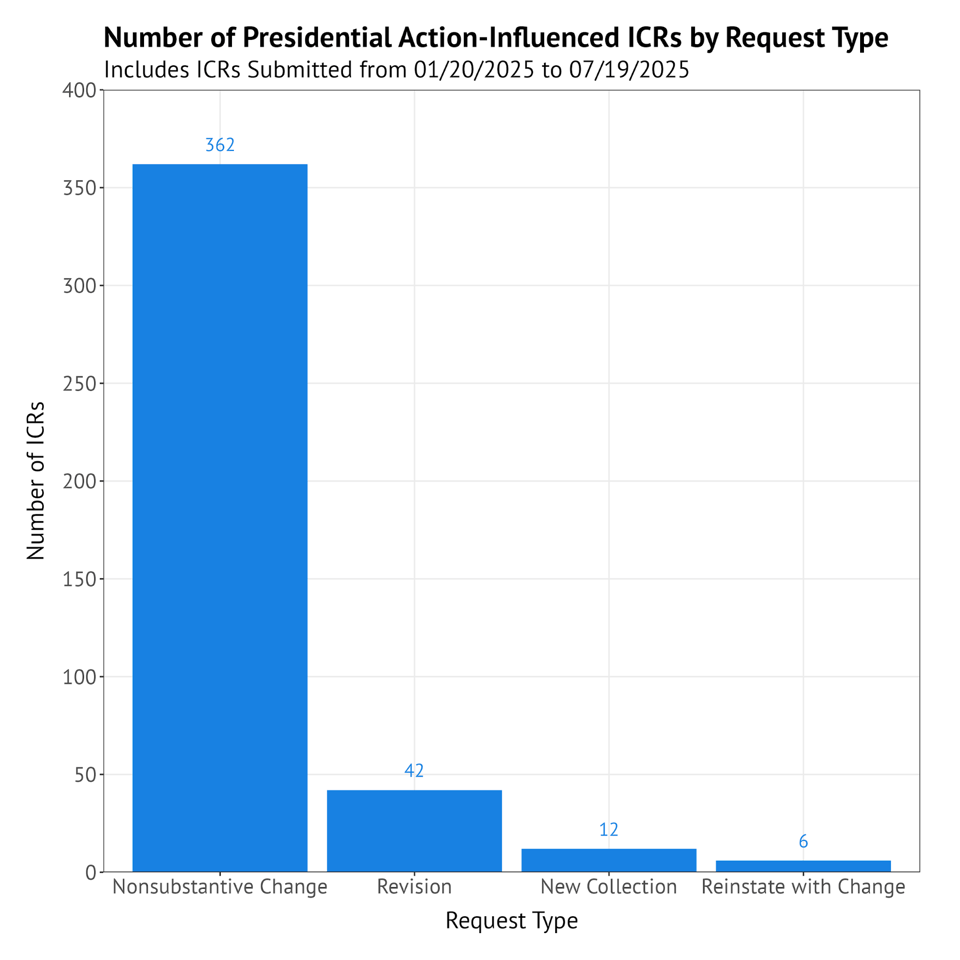
Looking at the request types of ICRs influenced by Presidential Actions, 86% (362 out of 422) of the ICRs requested a “no material or nonsubstantive change to a currently approved collection,” meaning no Federal Register Notice or public comment period was required. Among all nonsubstantive change requests reviewed, nearly two thirds (362 out of 583) were tied to Presidential Actions. Because these minor changes can be made without extending the collection’s expiration date, they can easily fly under the radar and move quickly through the approval process.
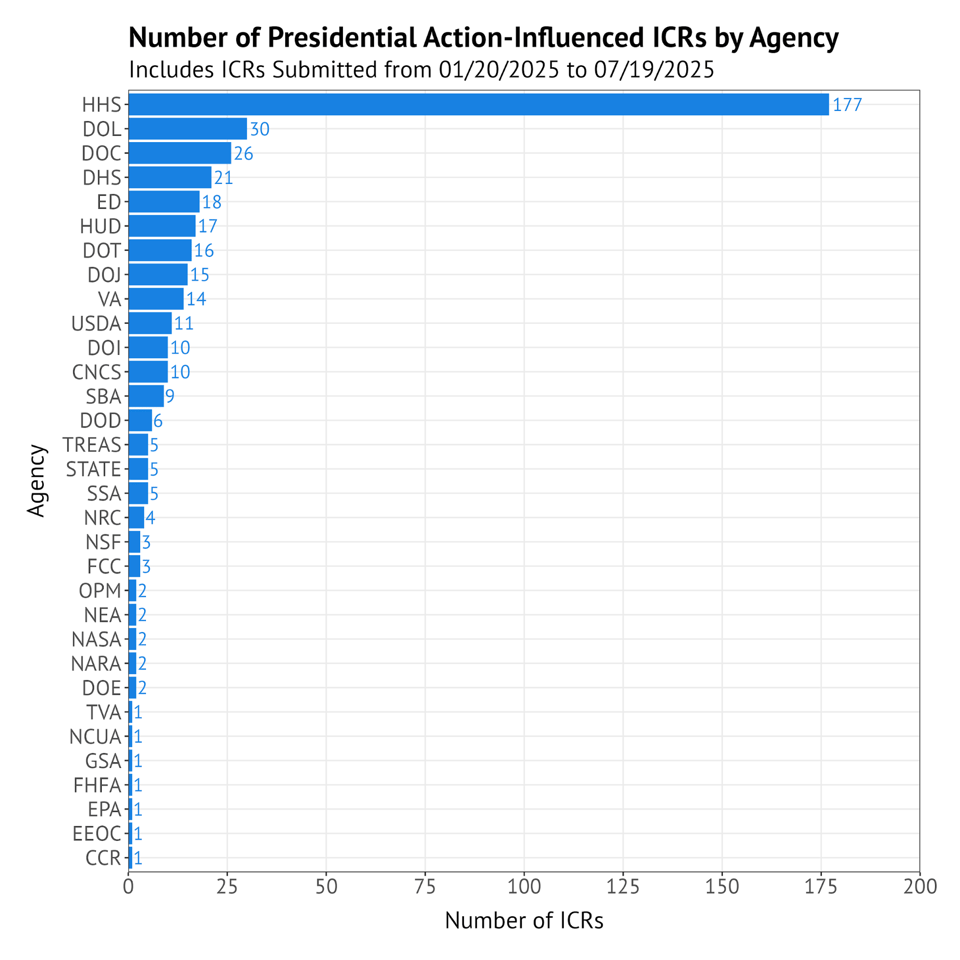
Looking at the agencies that submitted ICRs influenced by Presidential Actions, a total of 32 agencies were involved, though 20 of them had fewer than 10 ICRs each. HHS accounted for nearly half (42%) of all impacted ICRs, followed by DOL with 30 ICRs and DOC with 26 ICRs.
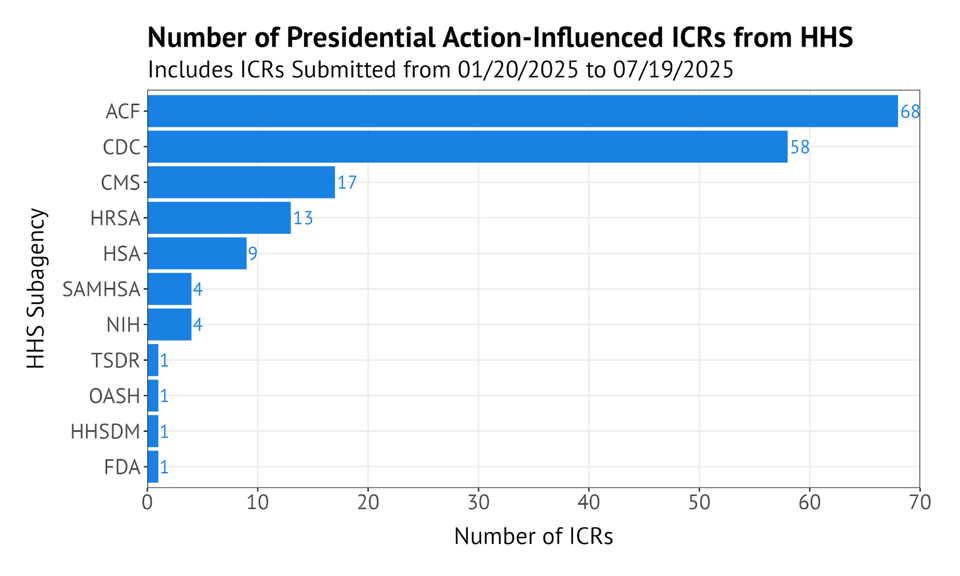
Zooming in on HHS, 11 subagencies submitted ICRs influenced by Presidential Actions, with most coming from the Administration for Children and Families (ACF) and the Centers for Disease Control and Prevention (CDC). The ACF accounted for 68 impacted ICRs, standing out for its efficient approach of consolidating multiple gender and DEI change requests into memos, though this often lacked detail compared to other submissions. The CDC accounted for 58 impacted ICRs, 54 of which were tied to EO 14168 Defending Women.
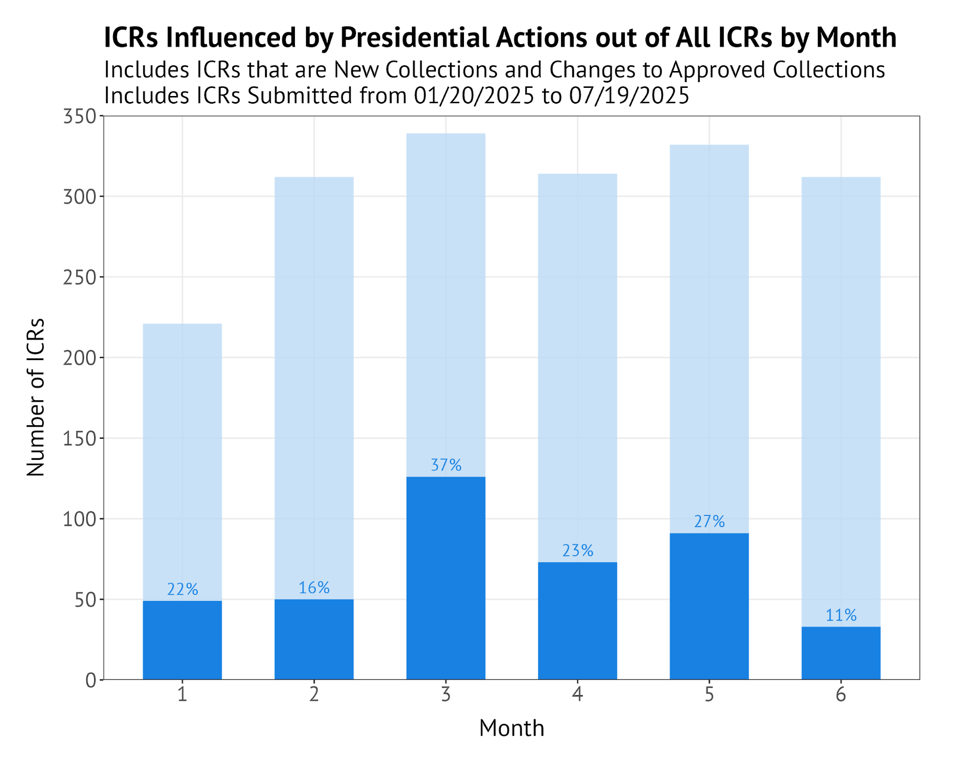
Of the 1,182 ICRs that were closely reviewed, 36% (422 ICRs) were influenced by Presidential Actions. Over each of the six months, the share of ICRs influenced by Presidential Actions ranged from a low of 11% (6/20/2025 to 7/19/2025) to a high of 37% (3/20/2025 to 4/19/2025).
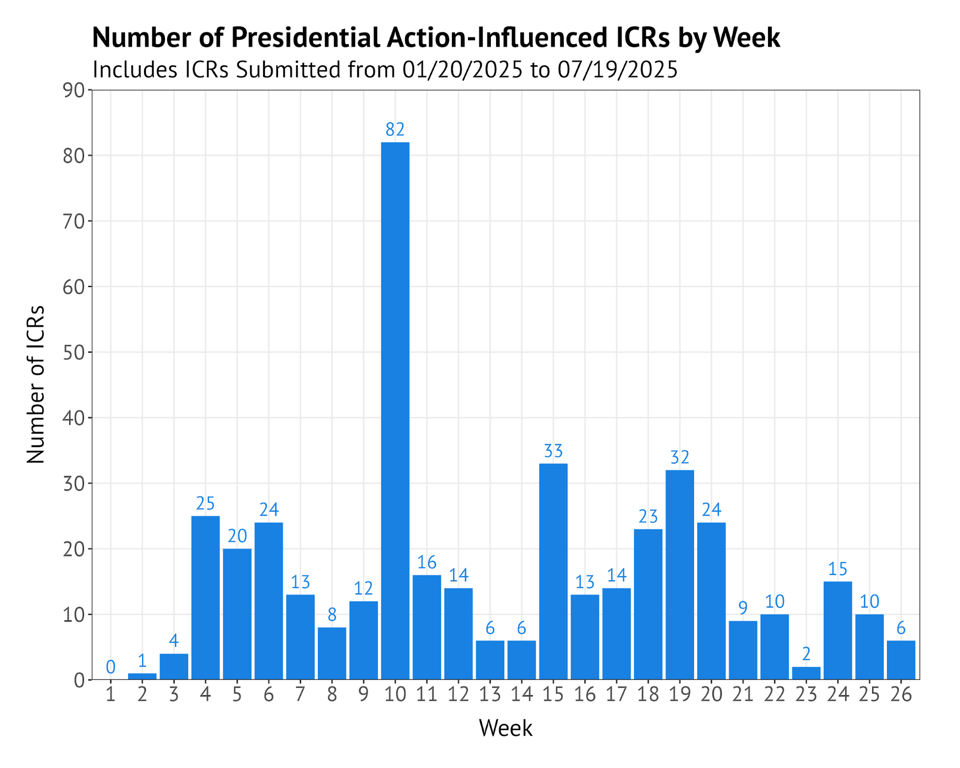
Zooming in from months to weeks, it can be seen that ICR activity typically peaks at the end of the month. Notable spikes in ICRs influenced by Presidential Actions appeared in weeks 10, 15, and 19. The largest surge came at week 10 (March 24–30, 2025), where 94% (77 out of 82) of the ICRs were tied to EO 14168 Defending Women.
Notable Changes
Among the three most influential Presidential Actions, several notable collections have been affected.
EO 14168: Defending Women From Gender Ideology Extremism and Restoring Biological Truth to the Federal Government – Changes look like deleting questions about gender identity, changing gender to sex, and removing response options, such as “transgender” and “non-binary.” Impacted collections include:
EO 14151: Ending Radical and Wasteful Government DEI Programs and Preferencing – Changes look like removing DEI-related questions, equity indicators, diversity statements, and textual references to DEI, as well as rephrasing terms like “health equity.” Impacted collections include:
EO 14148: Initial Rescissions of Harmful Executive Orders and Actions – Changes look like removing questions on civil rights, discrimination, sexual orientation, environmental justice, and more. Impacted collections include:
Model Medicare Advantage and Medicare Prescription Drug Plan Individual Enrollment Request Form
Request for Transfer of Property Seized/Forfeited by a Treasury Agency
To explore all 422 ICRs influenced by Presidential Actions, visit our Presidential Action ICR tracker.
How to Stay Informed
Our ICR trackers at dataindex.us are updated daily with newly scraped data to surface these changes as they are proposed. Every new ICR is reviewed to identify those influenced by Presidential Actions, and our weekly newsletter posts highlight the latest developments. Check out past newsletters to read detailed descriptions of changes being made. These quiet shifts in the federal data landscape may seem small, but they deserve our attention.
Sign up for our newsletter, and follow us on LinkedIn and Bluesky.